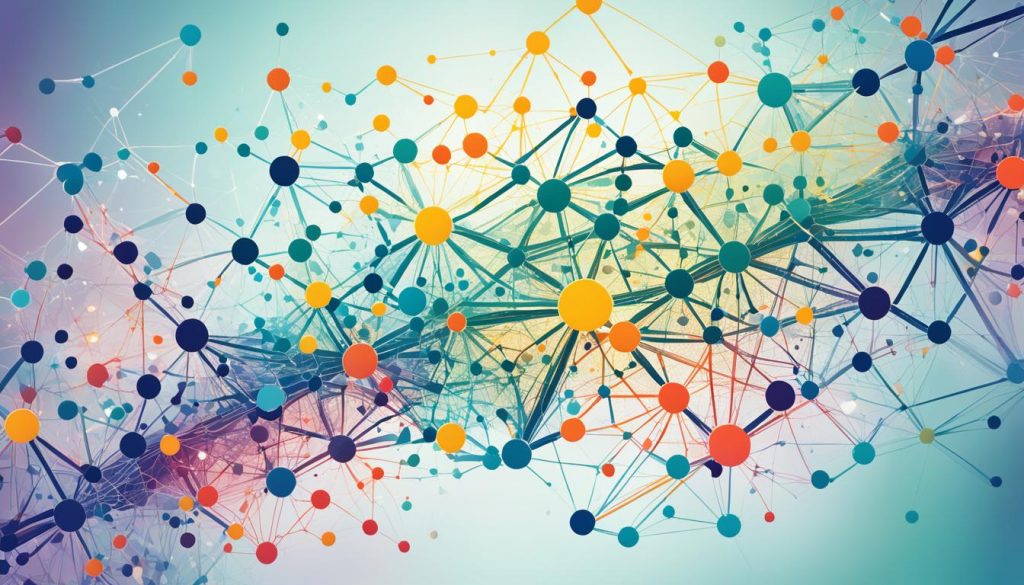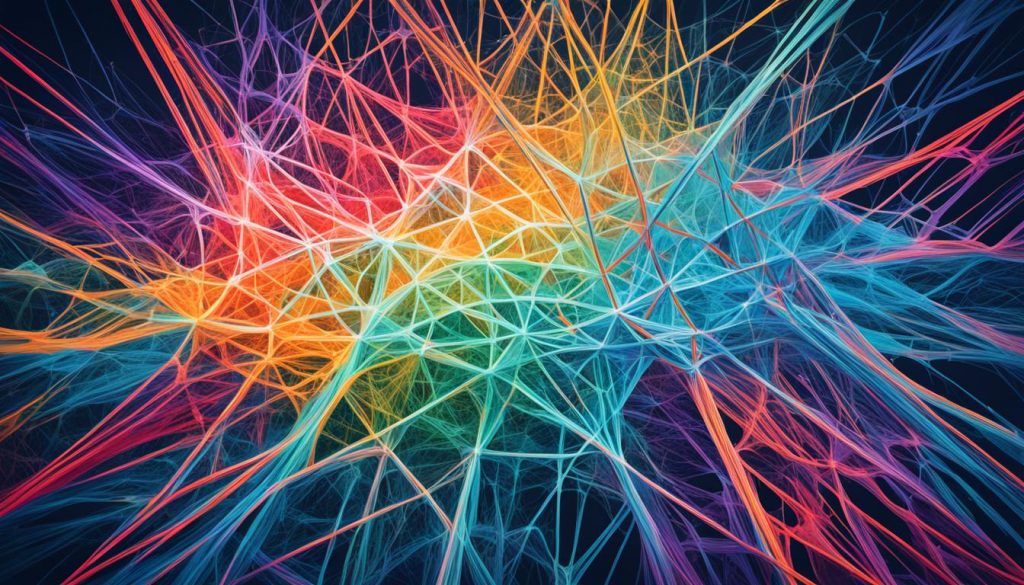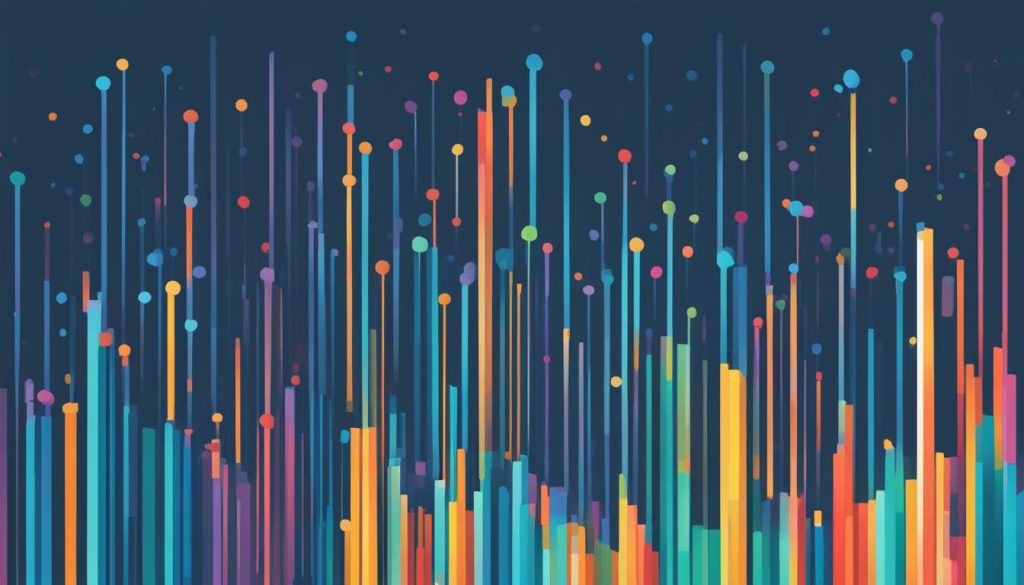Are you using Facebook AI tools to boost your competition engagement? In today’s digital world, old marketing ways might not work well. Facebook has many users and advanced AI. This lets you change how you advertise.
Think about ads that show the products people looked at recently. Or, think about using predictive analytics to spend your ad budget better. Facebook AI tools like Campaign Budget Optimization (CBO) help spread your budget to get the best results. This lets you focus more on being creative.
Small businesses often do well by making ads that target specific groups of people. Using machine learning in ad targeting helps your ads reach the right people at the right time. This can really help you stand out.
Using AI in Facebook marketing is now a must. These tools help make your ads better in real-time and give you tips for getting better results. Are you ready to use Facebook AI tools to improve your competition engagement?
Introduction to Facebook’s New AI Tools
AI in advertising has changed a lot in recent years. Now, machine learning helps us make ads better. For marketers, it’s key to know about these changes to make great campaigns.
The Evolution of AI in Advertising
AI is now a big part of ads. Facebook is adding new AI tools like Restyle and Backdrop to Instagram. These tools help make ads better and place them well. Meta AI works on many platforms, making user experiences better.
Key Features of Facebook’s AI Ecosystem
Facebook’s AI has many strong features for better ads. The AI Studio lets developers make AIs for customers. Meta Verified is also growing, helping businesses with trust and support.
| Feature | Details |
|---|---|
| AI Stickers | Billions sent monthly, rolling out to select users in WhatsApp, Messenger, Instagram, and Facebook Stories. |
| AI Studio | Enables development of branded AIs, accessible to developers outside Meta. |
| Meta Verified | Four subscription plans with core features like a verified badge and security checks. |
| Cultural Collaborations | Partnerships with icons such as Charli D’Amelio, Chris Paul, and Kendall Jenner. |
| Fresh’s Success | Achieved a 5x return on ad spend through Advantage+ shopping campaigns with generative AI variations. |
These AI tools do more than just help with ads. They’re part of a big plan that includes working with stars and new ideas. This keeps Facebook at the top of digital marketing.
The Role of Machine Learning in Facebook Advertising
Facebook uses machine learning a lot in its ads. Since 2006, it has gotten better at using data for better ads and more user interaction.

How Machine Learning Algorithms Optimize Ad Targeting
Machine learning helps make Facebook ads better. Advertisers give Facebook lots of data like who they want to reach and what they like. Then, Facebook’s AI picks the best place for ads.
It uses a formula: Advertisers Bid x Estimated Action Rate + Ad Quality = Total Value. This helps predict who will click on ads the most. So, ads go to the right people, making them more likely to buy something.
Real-time Ad Performance Analysis
Real-time performance analysis is key to Facebook ads. Tools like Meta Pixel track what users do, even outside Facebook. This helps make ads more personal and effective.
The AI also looks at how much you’re willing to pay and what you want to achieve. It picks ads that will do the best job. This means even small bids can win if they’re likely to get a good response.
So, Facebook’s use of machine learning changes how ads work. It helps advertisers make better choices and stay ahead in the fast-changing world of online ads.
Using Facebook AI Tools for Better Competition Engagement
Facebook AI Tools can really boost how well you connect with your competition. They use smart learning and predictive analytics to show ads to the right people at the best time. This helps make your brand stronger.
With AI content generation, making content that speaks to your audience is easy. Tools like Rytr help make Facebook ad campaigns better. They give detailed reviews to help you get the most from your investment.
Adding Facebook AI Tools to your marketing plan helps deliver ads better and gets more people involved. Facebook’s Power5 automated ad tactics are great at this. They work hard to use your budget well and reach more people.
| AI Tool | Utility | Cost | G2 Score |
|---|---|---|---|
| Circleboom Publish | Social media management | Pro Version: $24.99/month | 4.6 |
| Buffer | Social media scheduling | Pro Version: $30/month | 4.3 |
| Later | Instagram scheduling | Pro Version: $45/month | 4.5 |
| Lumen5 | Video creation | Paid Plan: from $29/month | 4.5 |
| Canva | Graphic design | Paid Plan: from $15/month | 4.7 |
| Copy.ai | AI content generation | Paid Plan: from $49/month | 4.7 |
Facebook also has tools like Meta Pixel to track what people do on your site. And AdClarity gives you deep insights into what your competitors are doing. This helps you stay ahead in the game.
Using AI can save advertisers up to five hours a week. AI makes things easier by giving you important info and metrics fast. With Facebook AI Tools, you can make sure your campaigns are always on point, relevant, and engaging.
With over three million advertisers on Facebook, the competition is tough. So, knowing how AI content generation and Facebook AI Tools can help you stand out is key. It’s important for anyone wanting to beat the competition and make a mark.
Personalizing Content with AI for Enhanced User Engagement
AI is changing how brands talk to people today. It uses cool tech like dynamic creative optimization (DCO) and sentiment analysis. This helps make marketing that really speaks to people and gets them involved.

Dynamic Creative Optimization (DCO)
DCO uses AI to test many ad versions to see which works best. It changes ads on the fly with real-time data. This means everyone sees the most interesting ad.
DCO cuts down on making ads and targets better, leading to more people buying things and caring more.
Utilizing Sentiment Analysis for Targeted Messaging
Sentiment analysis looks at how people feel about ads. It helps brands make messages that hit the mark. This makes people feel closer to the brand and more loyal.
Using AI tools together makes making content better. It makes sure every interaction feels special and important.
AI changes how we make content with tools like DCO and sentiment analysis:
- Audience Insights: AI tools look at what users like and want. They make experiences just for them.
- Real-Time Optimization: DCO changes ads as they go, making sure they’re always the best.
- Emotional Intelligence: Sentiment analysis checks how people feel. Brands make messages that touch people’s hearts.
With AI, brands can really connect with people. They use DCO and sentiment analysis to make content that matters. It’s not just about making things faster. It’s about making experiences that people love.
| Metric | Traditional Methods | AI-Driven Methods |
|---|---|---|
| Content Creation Time | High | Reduced by up to 40% |
| Ad Performance | Static and often outdated | Continuously optimized in real-time |
| User Engagement | Generic | Highly personalized |
| Customer Satisfaction | Mediocre | Elevated through tailored experiences |
Boosting Customer Interaction with AI Chatbots and Virtual Assistants
AI chatbots and virtual assistants are changing how businesses talk to customers. They make customer experiences better, faster, and more personal. This leads to happier customers.
These tools help businesses give support right away. They can talk to many customers at once and solve their problems with custom solutions.
Implementing Chatbots for Real-Time Customer Support
AI chatbots are changing the game for businesses. They can answer up to 80% of simple questions and work all the time. This means customers get help right away, which makes them happier.
Chatbots can talk in many languages, helping businesses reach more people. They can handle lots of questions at once, making things run smoother. This lets human workers focus on harder problems. Businesses can save money on customer service but still give great service.
Virtual Assistants for Personalized User Experiences
Virtual assistants make talking to customers even better by giving them personal help. They use what they learn from customers to make better suggestions. This makes shopping more fun and can lead to more sales.
Virtual assistants get better over time by learning from customers. This makes them very useful for keeping customers happy and loyal. They are also key in managing customer relationships, with 21.50% of chatbots used for this in retail.
More businesses are using virtual assistants. For example, the hospitality industry saw a 53% increase in chatbot use in 2022. This shows how AI tools are becoming more important for talking to customers and making things run smoother.
In conclusion, using AI chatbots and virtual assistants has many benefits. They offer real-time support and make customer experiences better. By using these tools, businesses can stay ahead in the digital world.
Optimizing Ad Spend with AI-Driven Analytics
In today’s digital world, making the most of ad spending is key for a good return on investment. AI helps a lot in this area. It lets marketers make smart choices and use their budgets well.

Leveraging Predictive Analytics for Budget Allocation
Predictive analytics uses past data to guess how ads will do. This helps marketers plan better. They can see what will work best and where to spend more.
AI can make ads more engaging and get more results for less money. It also helps find new people who might like the ads. Tools like AdEspresso and Trapica use advanced predictions to improve targeting.
Tools and Techniques for Cost-Effective Campaigns
Using the right tools and methods is key for ads that work well and don’t cost too much. AI can help with setting bids, finding the right audience, and making ads more effective. Here are some great options:
- AdEspresso: Tests different ads, offers dynamic ads, and goes beyond Facebook’s limits.
- Revealbot: Handles ads across platforms with automated rules for better ad performance.
- Canva: Gives access to over a million images and an AI search for creative ads.
- Zalster: Improves bids, budgets, and targeting with split tests for better results.
- Trapica: Uses AI to boost social media ads, stop ads that don’t work, and find audience details.
- Anyword: Creates ads with AI that perform well, cutting down on guesswork.
Improving ad targeting and creative with AI insights is crucial for better results and ROI. Testing AI-driven ad variations is a must for this.
AI-driven PPC tools can change the game for businesses. They look at lots of data to find trends, improve targeting, and automate bids. This helps in using ad money wisely and getting more conversions.
| Tool | Key Features |
|---|---|
| AdEspresso | Split testing, dynamic ads, advanced targeting |
| Revealbot | Automated rule builder, cross-platform ad management |
| Canva | AI-enabled search, extensive image library |
| Zalster | Bid and budget optimization, split testing |
| Trapica | AI campaign optimization, demographic insights |
| Anyword | Predictive performance scores, multilingual support |
Using these AI tools well can really improve campaign results. It offers long-term benefits and helps manage ad money better. By using AI for ad spending and budget, businesses can stay ahead in the fast digital world.
Enhancing Audience Insights with Facebook AI Tools
In today’s digital world, knowing your audience is crucial for ad success. Facebook’s AI tools help marketers understand their audience better. This lets them connect more with their target groups.
Audience Segmentation for Precise Targeting
Segmenting your audience is key for targeted ads. Facebook Audience Insights gives detailed info on age, gender, and more. This info helps marketers make ads that speak to specific people.
For example, 53% of people buy more when a product is endorsed on Reels. AI tools help advertisers focus on these trends. This way, ads hit the mark better.
Mining User Data for Strategic Insights
Looking into user data reveals important insights for ads. Facebook’s AI tools check user actions like likes and shares. This helps make ads that people want to see.
For instance, Reels get shared 3.5 billion times a day. This shows how powerful this format can be. By using this data, marketers can make content that gets more attention and sells more.

Using AI and user data also helps improve ad strategies. Advertisers can find out who buys a lot of certain products. Facebook’s AI also suggests personalized content to creators, making ads more relevant.
Facebook’s AI tools are changing how ads reach their audience. They help with detailed audience insights and data mining. This leads to stronger connections and better ad results. Using these tools gives brands an edge in the fast-changing digital market.
Best Practices for Implementing Facebook AI Tools in Your Campaigns
Using Facebook AI tools needs a careful and smart plan to get the most from AI in ads. By following top tips, your ads will be more engaging and effective.
Starting a successful Facebook AI implementation means setting clear goals. Think about what you want to achieve, like more people engaging with your ads or better return on ad spend (ROAS). This helps the AI tools work better.
Creating different ad content with AI tools is a smart move. AI can make many ads fast, speeding up testing. This saves time and shows what words and feelings work best with your audience, leading to more sales.
It’s key to watch and tweak ad campaign strategies with the latest data. AI looks at lots of data to find out who likes your ads the most. Using this info helps make your campaigns better and more engaging.
- AdEspresso by Hootsuite makes A/B testing and checking results easier.
- Revealbot helps manage campaigns and analyze them in real-time.
- Madgicx uses predictive analytics to make ads better.
For great Facebook AI use, use ads that change based on what users like. AI picks the best ads and designs to get more people involved. This keeps your campaigns getting better.
Using AI tools also means using AI to spend your ad budget wisely. AI gives tips on where to spend your money for the best results. This makes your strategy cost-effective and boosts your campaign’s success.
| AI Tool | Key Feature |
|---|---|
| AdEspresso by Hootsuite | Streamlines A/B testing and analytics |
| Revealbot | Advanced automation and real-time analysis |
| Madgicx | Predictive analytics for ad optimization |
| Smartly.io | Automation and optimization for big advertisers |
| Zalster | Automates optimization for targeting and bidding |
| Trapica | Changes targeting based on up-to-date conversion data |
| Adext AI | Improves audience targeting with machine learning |
| Albert | Autonomous digital marketing AI |
| StitcherAds | Automates and personalizes ad campaigns for retailers |
By always checking how things are going and adjusting with AI tips, you keep your campaigns up-to-date. This means better engagement, easier ad making, and better campaign results.
Challenges and Considerations When Using AI in Advertising
Using AI in ads has many challenges. These include privacy, data security, and bias in algorithms. As AI gets better, these issues become more important.
Privacy and Data Security Concerns
One big issue is keeping data private and secure. AI uses a lot of data from consumers. Advertisers must be clear and follow rules like GDPR. DataRobot’s 2022 survey found 62% of lost revenue comes from data bias.
It’s also key to protect consumer info to build trust. Automated tech makes data breaches worse.
Managing Algorithmic Bias
Another big worry is bias in algorithms. AI ads change based on data and feedback. But, biased algorithms can target unfairly. Marketers must check their AI for bias.
Deloitte Insights say 64% of marketers fear AI could hurt creativity. Using AI responsibly means balancing new tech with ethics. A report by Ascend2 shows 47% of customer journeys could lose the personal touch with too much AI.
Using AI also means changing how companies work. We must tackle these challenges to keep ads fresh and right.
Future Trends in Facebook AI Tools and Advertising
We’re on the edge of a big change in digital ads with Facebook’s AI tools. Using AI in ads will be key for brands to keep up. We should watch for trends like augmented reality and voice search.
Augmented Reality and AI Integration
AR and AI will change how we see ads. They will make ads more fun and work better. For example, you can try on clothes or see how furniture looks in your home with AR.
This makes ads more fun and helps people buy more.
Studies show that using AI for video ads can make ads work twice as well. Facebook is working on AI to make ads better. They want to make ads more real with AR.
Voice Search Optimization
More people are using voice search with tools like Amazon’s Alexa and Google Assistant. Making ads work well with voice search is key. Facebook is making ads better for voice search by making ad headlines more catchy.
AI will help make ads that really speak to people. It will help target ads better and make them more effective. This means ads will match what people are asking for out loud.
In short, knowing about AR and voice search will help advertisers use Facebook’s AI tools well. As AI in ads grows, using these trends will help brands stay ahead. It will make their ads more exciting and effective.
Conclusion
Looking into leveraging AI for Facebook ads shows how it changes digital marketing. Facebook’s AI helps make ads better, manage budgets, and talk to users in a new way. This helps brands make their ads more powerful and connect better with people.
The Facebook AI impact on marketing is huge. Tools like dynamic creative optimization, chatbots, and predictive analytics make ads work better. They help marketers make ads that really speak to people and get more attention.
To win in today’s market, advertisers need to keep up with AI trends and best practices. Using AI in ads helps brands do better, spend money wisely, and make ads that feel personal. As digital marketing keeps changing, using Facebook’s AI will be key to success.
